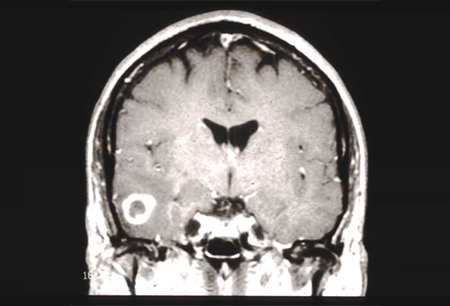Summary
Definition
History and exam
Other diagnostic factors
- altered mental status
- headache
- nausea and/or vomiting
- gait abnormality
- ataxia
- weakness
- seizures
- visual disturbances
- speech deficit
- aphasia/dysphasia
- sensory deficit
- motor weakness
- visual change
- cranial nerve palsy
- papilloedema
- personality change/emotional lability
Risk factors
- white ancestry
- male sex
- neurofibromatosis type 1
- tuberous sclerosis complex
- Li-Fraumeni syndrome
- Turcot's cancer syndrome
- ionising radiation
Diagnostic investigations
1st investigations to order
- MRI head
- ophthalmological evaluation; visual field testing
- CT head
- brain MR spectroscopy
- brain perfusion MRI
- histopathology
- molecular analyses
Treatment algorithm
Contributors
Authors
L. Nicolas Gonzalez Castro, MD, PhD
Instructor in Neurology
Center for Neuro-Oncology
Dana-Farber Cancer Institute and Brigham and Women's Hospital
Harvard Medical School
Boston
MA
Disclosures
LNGC has received consulting fees from Elsevier, Oakstone Publishing, and Teladoc. LNGC has received research funding from Merck & Co. (to Dana-Farber Cancer Institute). LNGC is an author of a number of references cited in this topic.
Acknowledgements
Dr L. Nicolas Gonzalez Castro would like to gratefully acknowledge Dr Timothy C. Ryken, Dr Linton T. Evans, Dr Manmeet S. Ahluwalia, Dr Susan Chang, and Dr Karine Michaud, previous contributors to this topic.
Disclosures
TCR is an author of a number of references cited in this topic. MSA has acted as a consultant for Elekta, Incyte, AstraZeneca, Novocure, Caris Life Sciences, Bristol-Myers Squibb, Monteris Medical, AbbVie, MRI Solutions, Elsevier, and Prime oncology. MSA has received clinical trial investigations grants from Tracon, Bristol-Myers Squibb, AstraZeneca, Novartis, and Novocure. SC has received research support from Agios, Novartis, Quest, Roche, and Schering Plough. KM and LTE declare that they have no competing interests.
Peer reviewers
David A. Reardon, MD
Associate Professor
The Preston Robert Tisch Brain Tumor Center
Duke University Medical Center
Durham
NC
Disclosures
DAR declares that he has no competing interests.
Peer reviewer acknowledgements
BMJ Best Practice topics are updated on a rolling basis in line with developments in evidence and guidance. The peer reviewers listed here have reviewed the content at least once during the history of the topic.
Disclosures
Peer reviewer affiliations and disclosures pertain to the time of the review.
References
Key articles
Louis DN, Perry A, Wesseling P, et al. The 2021 WHO classification of tumors of the central nervous system: a summary. Neuro Oncol. 2021 Aug 2;23(8):1231-51.Full text Abstract
National Comprehensive Cancer Network. NCCN clinical practice guidelines in oncology: central nervous system cancers [internet publication].Full text
Weller M, van den Bent M, Preusser M, et al. EANO guidelines on the diagnosis and treatment of diffuse gliomas of adulthood. Nat Rev Clin Oncol. 2021 Mar;18(3):170-86.Full text Abstract
Liau LM. Guidelines for newly diagnosed glioblastoma. J Neurooncol. 2008 Sept;89(3).Full text
American Association of Neurological Surgeons; Congress of Neurological Surgeons. Updated AANS/CNS guidelines for progressive glioblastoma patients. Jun 2022 [internet publication].Full text
Reference articles
A full list of sources referenced in this topic is available here.
Use of this content is subject to our disclaimer
